The Review | Twelve Protectors in a grouptest

E-Mountainbiking places many and varied demands on knee pads. They have to offer as much protection as the thickest downhill protectors, be light and comfortable to wear, and not get in the way when you’re pedaling all day. Until a few years ago it was simply impossible to reconcile these different qualities in one pad. However, the arrival of highly functional and flexible soft foams (which stiffen on impact and absorb the energy of a fall) has led to very versatile protectors and a wide range of choices for the buyer. So we invited twelve of the latest generation of knee pads to submit to a thorough test, putting them through their paces in the lab and on the trail.

As well as getting feedback from our experienced testers on the pads’ comfort, heat build-up, and handling, we also decided to do more objective tests on their core function: protection. Each pad went through a rigorous test in the SAS-TEC laboratory in Markgröningen. A standardized test facility was used to examine the protective qualities and cushioning features of the various types of padding used and the knee protector as a whole.
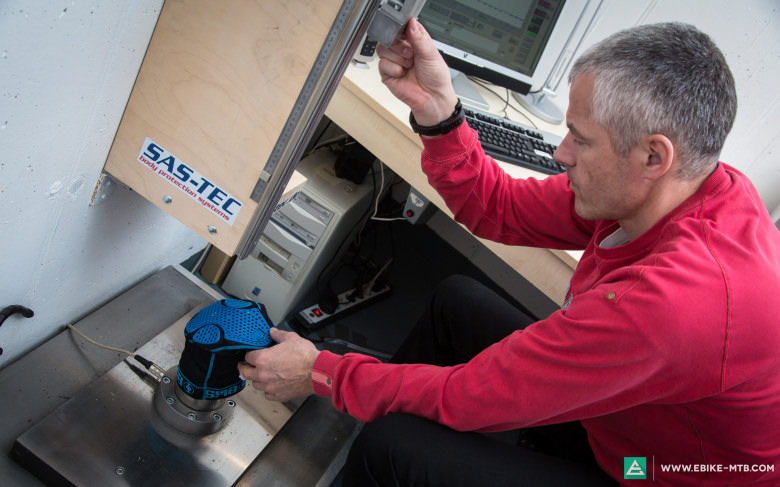
A drop weight hit the pad with an impact energy of 50 joules, and the residual energy was recorded to the millisecond by a computer. The resulting curve allowed us to read both the greatest force applied and the time period over which the impact energy was distributed. Using the EN 1621-1 standard for knee and elbow protectors, we tested the padding of each protector at three points and at a central point on the whole pad. To conform to the standard, the average residual force must not exceed 35 kilonewtons, nor must one individual impact be over 50 kilonewtons.

For optimal protection, it is vital that the maximum impact on the knee is as small as possible, but also that it takes as long as possible for the force to be transferred to the knee. This is where the increased cushioning of thicker pads makes them much more effective than thin protectors such as the Bliss ARG Minimalist, which still absorb an astonishing amount of force relative to their extremely thin construction.
Bliss Arg Knee Pad
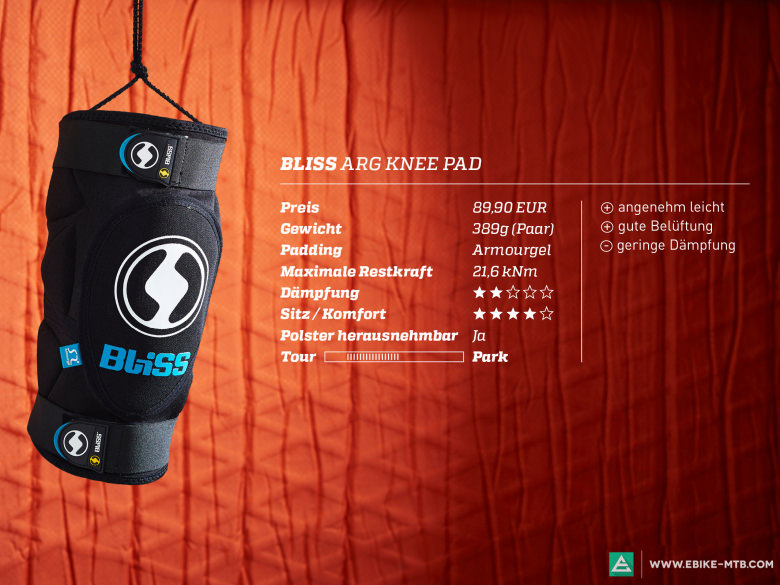
The Bliss ARG Knee Pad is one of three protectors tested which relies on a 4mm thick Armourgel padding and shows similar cushioning features to the others of this type: the foam absorbs an astonishing amount of force considering how thin it is, but its absorption values place it at the bottom of the test field. Nevertheless, the Bliss pad impressed us in terms of comfort and ventilation. At 389g, it is one of the lighter models. The two Velcro straps keep the pad firmly on the knee, and the rubber ends make it easier to put the pads on or remove them with gloves on. Even on longer rides with lots of pedaling we didn’t need to readjust them, a big plus compared to the lighter Minimalist model.
Bliss Arg Minimalist Knee Pad
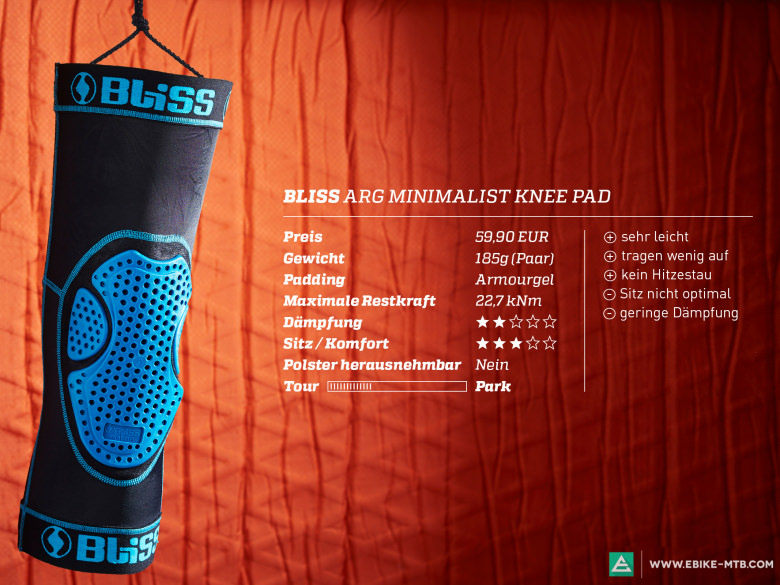
The Bliss ARG Minimalist is a variation of the ARG protector stripped down to the essential element: the protective padding. The light 185g pads are nicely finished and you hardly notice you have them on; even with long trousers on, they are unobtrusive. They didn’t sit so well on the knee despite the rubberized anti-slip on the flexible bands at the top and bottom. On bumpy trails some testers noted a tendency for them to slip down the leg. In contrast, the pads’ good ventilation and comfortable position when pedaling made them nice to wear for longer rides. If you are in two minds about which size to get, choose the smaller size: the Bliss pads tend to run fairly big. In the laboratory the Bliss protectors absorb impacts fairly well considering the small amount of cushioning they offer, and easily conform to the maximum force required by the test standard. Nevertheless, they provide less security than pads with thicker padding. Missing here is the cushioning effect which spreads the impact force over a longer time period.
G-Form Knee Pads
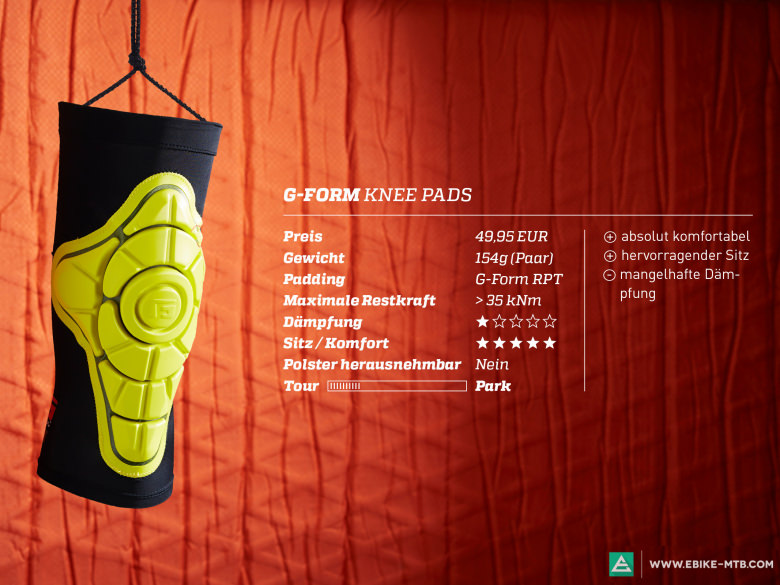
At 154g the G-Form knee pads (available in bright yellow or sober black) are by far the lightest pads on test. It is claimed that they combine a comfortable fit with good features for pedaling and the best possible protection. Indeed: thanks to the many individual segments they are made from, the pads slide smoothly onto the knee of the wearer like a second skin.
After a short time you forget you are even wearing them. Long rides and rough descents don’t bother them, either. The fit is perfect and their slim construction prevents heat build-up. There is a downside, however: even at a drop height of 75 cm (i.e. much lower impact forces than the regulation standard prescribes) the residual force exceeds the permitted maximum values.
Ion K_Pact Kneepad

The first thing you notice about the ION K_PACT is the distinctive shaping of the whole protector: the cut and position of the padding are designed specifically for a bent knee. This means that on the bike they sit perfectly in position on the leg and are comfortable to wear. Off the bike, however, they feel awkward when walking, although those who undertake excessive hikes will probably do it without pads on anyway. Comfort when pedaling is excellent, but the ION protector does feel a little bulky. Padding at the sides offers extra protection, but also allows heat to build up. The K_PACT achieved good maximum force results in the lab test. Moreover, the molded SAS-TEC padding distributes the force over a relatively long time period, further protecting the knee.
IXS Carve Knee Guards
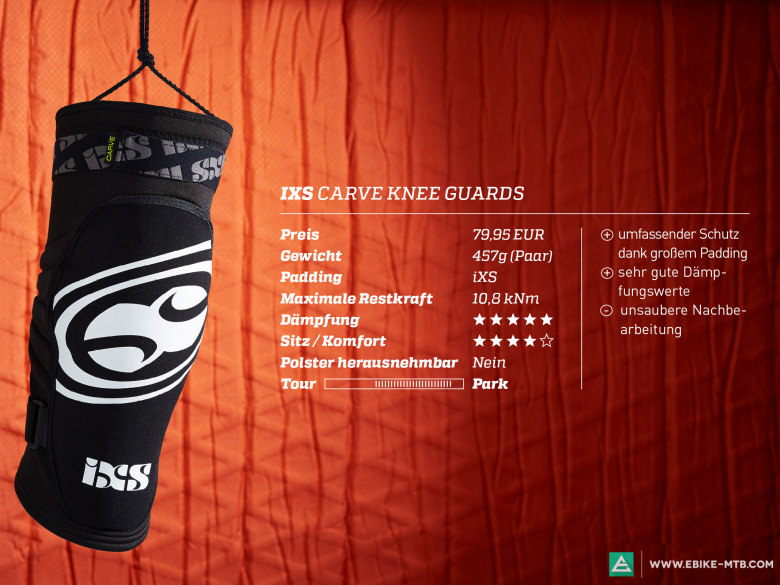
The foam padding used in the iXS Carve Series Knee Pad has the greatest surface area of any pad in the test and thus provides extensive protection: the protector also goes around the knee at the sides and extends further down the shin than its competitors. The foam mixture used in the padding was developed by iXS itself and impressed us in the lab test with outstanding impact absorption values. Heat management was less impressive: the Swiss company provides a breathable mesh at the hollow of the knee and thus the potential for heat removal, but on our test model most of the air holes in the padding were blocked due to poor finishing at manufacture. On the other hand, the fit is good: once in position and fastened with the two Velcro straps, not even the wildest descents or the longest pedaling sessions can shake the Carve.
IXS Dagger Knee Guards
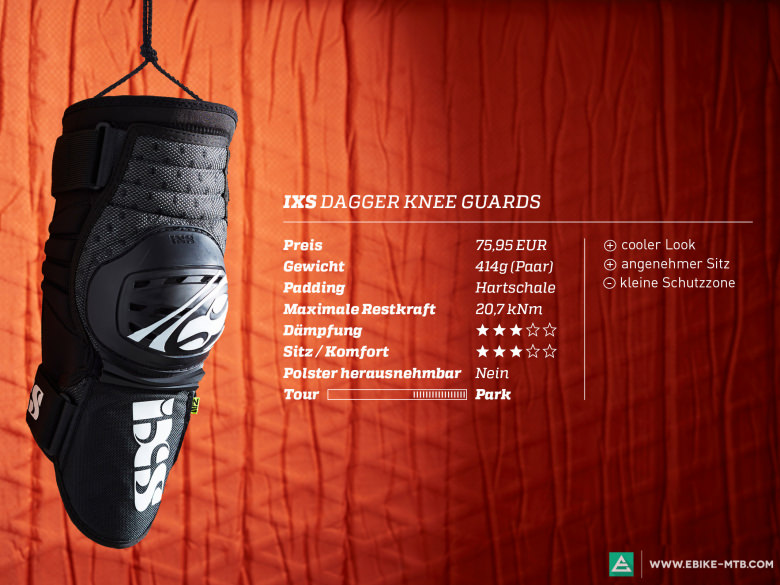
The iXS Dagger Knee is the only protector in the test to use a hard plastic shell for protection; the distinctive but cool look jumps out at you immediately. The Velcro straps are sensibly positioned on the well-finished protector, and ensure a good fit however wild things get. The Dagger is easy to wear and copes well with short bursts of pedaling, even though it probably isn’t great for longer rides. The hard shell itself is actually quite small, but it does a good job of protecting the essential parts of the knee. Values were merely average in the lab test although it is worth noting that the force is distributed over a wider area. The protective area underneath the plastic absorbs very little force. In the event of a fall, you should probably aim for the plastic!
O‘NEAL AMX Zipper Knee Guard

The AMX Zipper Knee Guards from O’Neal can be opened, as the name suggests, with a zipper attached to the side. In this way the pads can be taken off in seconds before longer uphill sections and put on again just as quickly when it really matters: no more hassle with removing shoes. On the inside the zipper is covered with soft material which adds to the overall comfort. The AMX Zipper could be a little more flexible for pedaling, although it didn’t really chafe. The Velcro straps at the top and bottom ensure that it doesn’t slip even when shaken hard. The large padding from SAS-TEC passed the lab test with good results. At 360g, it is also very light.
Poc Joint VPD 2.0 Knee
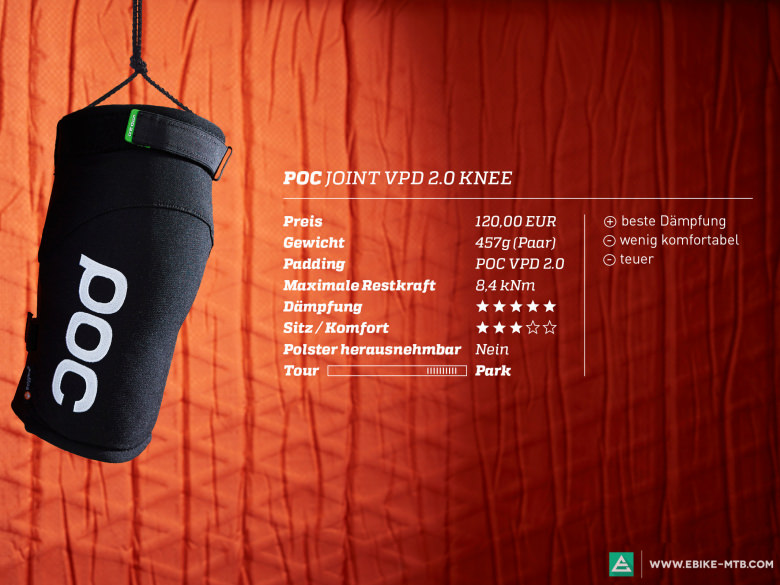
The thick padding of the POC VPD 2.0 Knee helped it win first place in the laboratory part of the test. The voluminous protector absorbs more impact energy than any of the others and scores well because it completely covers the whole knee. The pad is cleanly designed but the thick padding makes it seriously stiff, meaning it doesn’t fit the knee as snugly as its competitors and is thus less comfortable. It’s not bad for pedaling, but the POC probably feels more at home on downhill-oriented lift-accessed rides or bike park visits. The Velcro straps keep the 457g pad in position fairly well despite being rather thin, but on long rides they cut into the leg a little too much. The POC VPD 2.0 Knee has a high-quality finish but also a high price: at 120 euros they aren’t exactly giving it away.
Scott Grenade Pro 2 Knee Guards

The 600g Scott Grenade Pro 2 are the heaviest pads on test by some margin. The substantial padding goes some way to explaining this: at the front the knee is protected by a combination of D30 padding and foam cushioning; at the sides and back there are additional thick foam pads. The Scott Grenade Pro provides complete all-round protection. The sense of security we felt on the trail was confirmed in the lab: the D30 padding absorbs the most energy of all the pads tested. Such protection inevitably compromises ventilation: your knee gets very warm under the 100 euro pad despite the small amount of mesh used at the back. Nevertheless, the pad leaves nothing to be desired in terms of fit and comfort. The wide Velcro straps keep it reliably in position, while the pre-molded profile and the extra padding underneath make the pad nice and comfortable, even when pedaling.
Scott Tactic Knee Guards
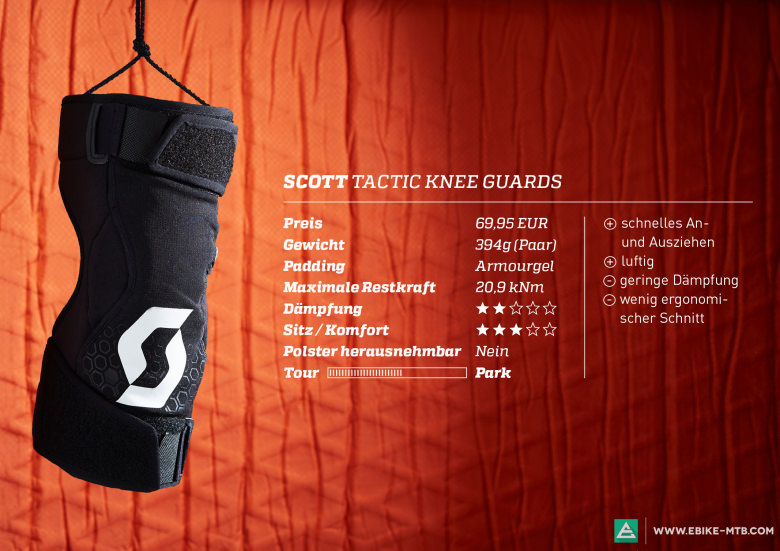
Compared to its rather bulky sibling the Grenade Pro, the Tactic is a lighter Scott model. Like the Bliss protectors, the Scott pad relies on a light and thin Armourgel padding positioned on the knee using a neoprene construction which is open at the back. This can be opened completely, making it very practical if you want to put it on or remove it without taking off your shoes. The wide Velcro straps are intelligently placed and do a good job of stopping the pad from slipping. The Scott feels generally comfortable and well-ventilated. The protector comes in a universal size, but we feel it could benefit from being a little tighter: it gives way and folds a little at the side, especially when pedaling. The pad achieved a maximum force of 20.9 kN in the laboratory absorption test, placing it within the limits of the regulation standard, but at the lower end of the test field with the other light protectors.
SixSixOne Evo Knee

SixSixOne sent its Evo Knee Protector to the competition. The protector has a high-quality finish and the Kevlar front looks truly indestructible. The high 494g weight testifies to the fact that no compromises have been made in terms of durability. The pad uses just one Velcro fastener at the top and an elastic strap takes care of stability at the bottom. This works well: The Evo Knee remains in place without slipping. It copes well with long pedaling sessions and rough descents. The open design at the back prevents heat accumulation, but also means that the pad does not rest against the leg at the sides, curving away from the knee slightly. The fit as a whole is rather loose. During the test, this meant that lumps of mud kept getting into the opening at the back of the knee and collecting in the pad: annoying. In contrast, the protective qualities of the pad gave us no cause for concern; the 661 at the front contributed to this.
Sweet Protection Bearsuit Knee Pads
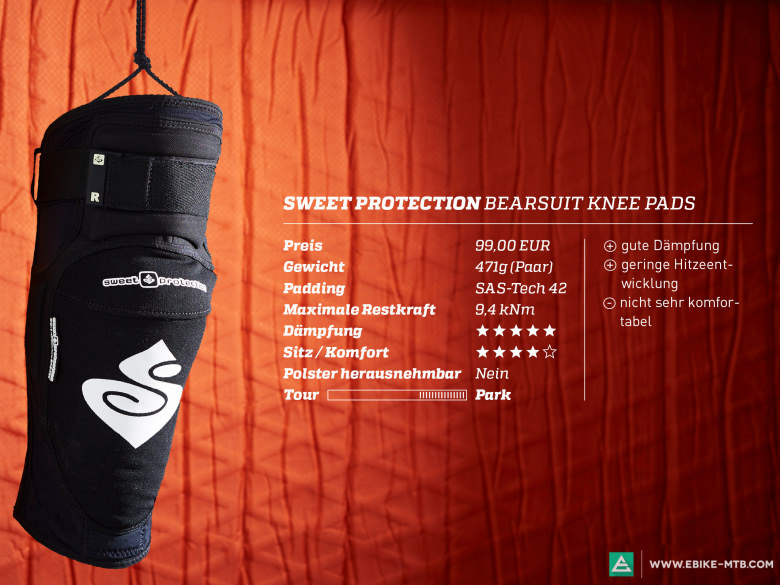
The Bearsuit Knee Pads from Sweet Protection came very close to winning the lab test thanks to their very good absorption values, narrowly missing out to the POC model. The SAS-TEC padding used also excelled at distributing the impact over a long time period. The first time we put them on, we were immediately struck by the extensively pre-molded shape of the pad. It was uncomfortable in a standing position, but not so on the bike: with bent knee the fit is perfect. While pedaling, however, they feel quite hard and bulky and not particularly comfortable. The Neoprene sleeve hugs the knee fairly tightly, but this didn’t seem to cause much heat build-up. Sweet only uses one Velcro strap at the top closure, but the pads remain firmly in position despite this. The secret is the large rubber surfaces on the inside of the protector. These work well until you start sweating a lot: then the fit becomes average at best.
Conclusion:
Even though modern protectors are generally very versatile, our test shows a wide variety of approaches to protection. First we have the ultra-light protector faction aiming for maximum comfort with thin protective padding and accepting the fact that this offers less effective protection.
G-Form knee pads, for example, feel like a second skin. However, they significantly exceed the permitted residual force for knee protectors stipulated in the EN 1621-1 standard. The Bliss ARG or the Scott Tactic pads are a safer bet in this group. The latter can be put on without removing your shoes, which is a plus. On the other hand, they don’t sit as well on the knee as the Bliss model despite having the same padding. The middle group consists of versatile protectors with thicker foam padding which are still good for pedaling, but considerably warmer due to their sturdier construction. This is the place to look if you’re searching for an all-rounder: the O’Neal AMX Zipper Knee Guard, for example – it too can be put on and removed quickly thanks to its zipper. The third category contains knee pads which are suited more for downhill operations: pads with excellent cushioning which are often enhanced by protective areas on the sides of the knee. Here the protective aspect is more important than perfect comfort for pedaling or heat management. In our opinion, the most impressive pad in this category was the well-cushioned and very comfortable Scott Grenade Pro 2.
Words: Aaron Steinke Photos: Fabian Rapp
Did you enjoy this article? If so, we would be stoked if you decide to support us with a monthly contribution. By becoming a supporter of E-MOUNTAINBIKE, you will help secure a sustainable future for high-quality cycling journalism. Click here to learn more.








